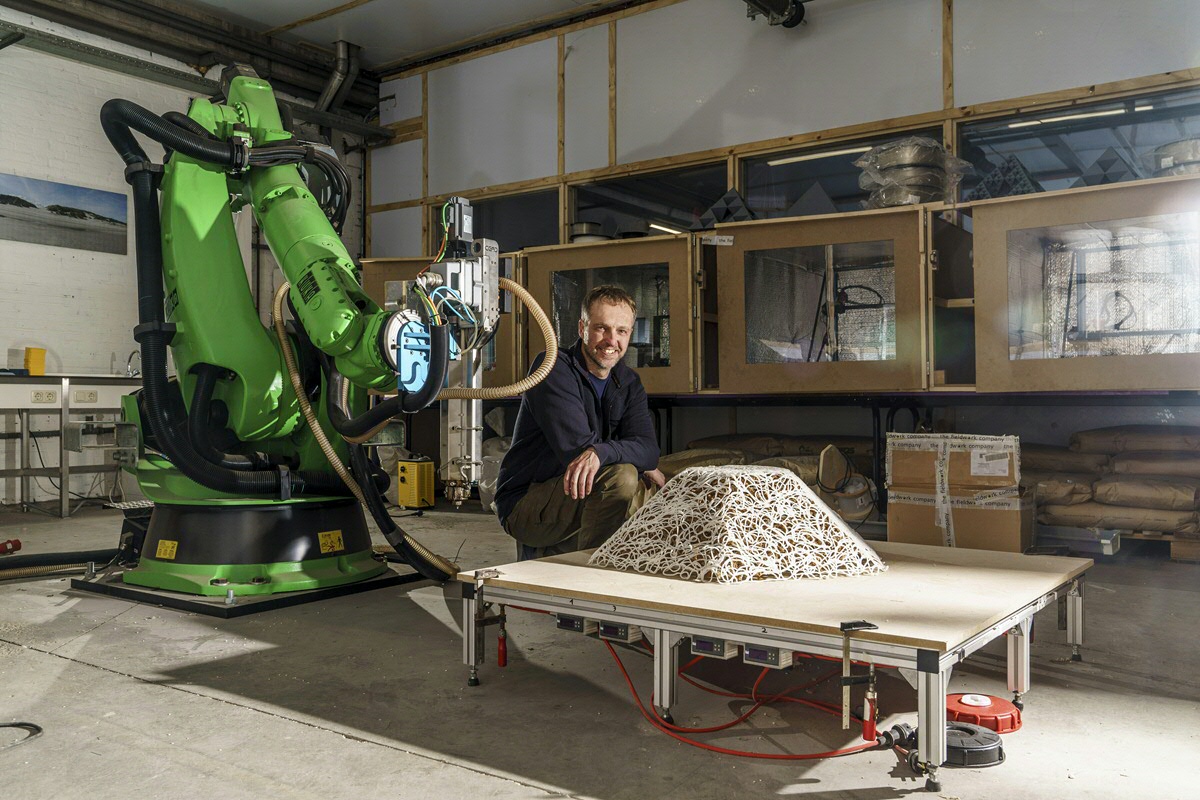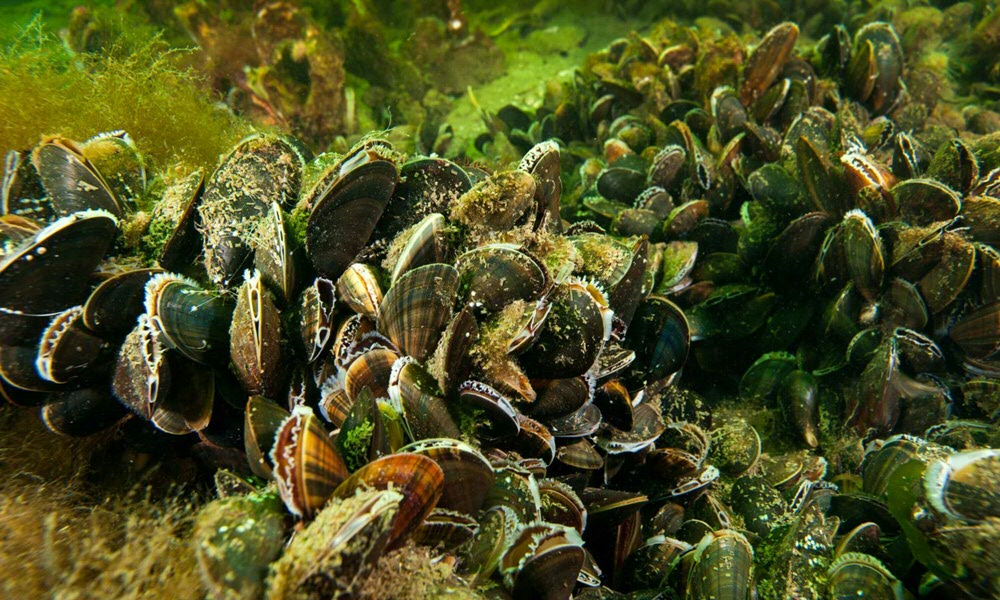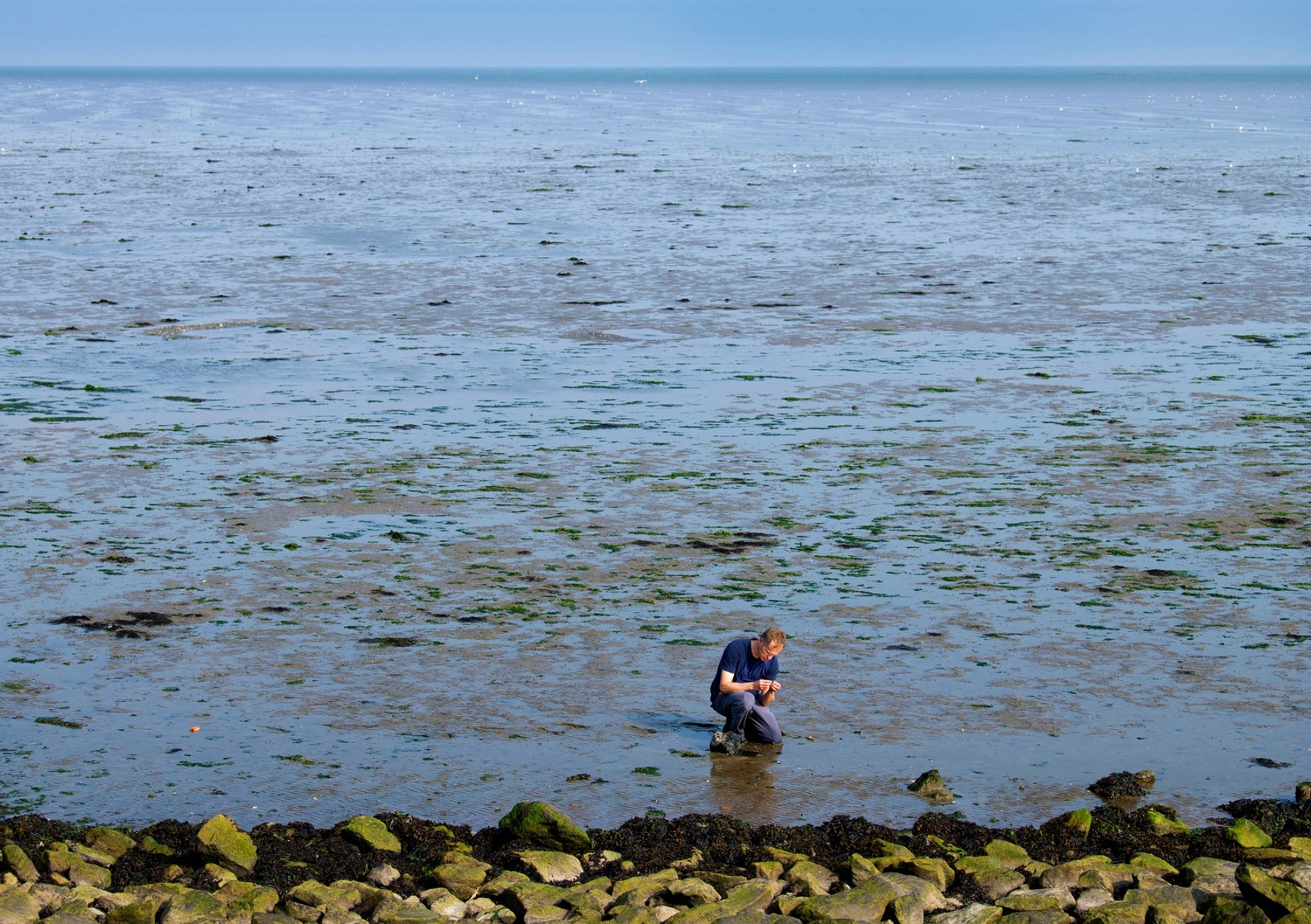One mussel doesn't make a reef
Professor of Coastal Ecology Tjisse van der Heide is conducting research into the restoration of mussel banks and other bio-builders, as the living organisms that shape the Wadden landscape are known. Armed with a 3D-printer and industrial design methods, he became a bio-builder himself and is now searching for ways to restore these systems.
Text: Nienke Beintema / Photos: Olaf Kraak, Reyer Boxem and Cor Kuijvenhoven
An enormous, bright-green robot arm has been constructed in a warehouse on an industrial estate in Groningen. It is two metres high, one metre in diameter, and weighs hundreds of kilos. It was once used to weld components together for a major a car manufacturer. Now the arm has a 3D print head, allowing it to print biodegradable baskets the size of a large barbecue dish. Tjisse van der Heide shows us a whole pile of them, in all different shapes and sizes. ‘These will soon be on the bed of the Wadden Sea,’ says the Professor of Coastal Ecology at the UG and researcher at the Royal Netherlands Institute for Marine Research (NIOZ).

Bioplastic
But why…? Why place plastic structures – even if they are bioplastic – in our beautiful Wadden Sea? Van der Heide settles himself down and produces some pictures on his laptop. The so-called bio-builders (also known as ecosystem engineers) play an important role in sandy coastal ecosystems like the Wadden Sea, he explains. They are living organisms that help to shape the landscape. Van der Heide: ‘Bio-builders are both literally and figuratively the foundations of the ecosystem.’ Mussels, for example, form mussel banks on which young mussels can live and which also serve as a home for various other forms of sea life. Grains of sand get caught in marram grass and ultimately form sand dunes. Salt marsh plants trap sludge and gradually form a salt marsh. And sea grass traps and holds on to sediment from the water, forming an important habitat for other marine species.
Protected and cleaner
But these natural ecosystems have disappeared in many places in the Wadden Sea,’ explains Van der Heide. ‘The mussel and oyster banks have long been overfished. Sea grass was badly affected by a disease, the construction of the Afsluitdijk, agricultural fertilizers, and phosphates from detergents.’ Now that the Wadden Sea is better protected and cleaner, we should see a return of these species. It should also be remembered that salt marshes, reefs, and dunes are a welcome weapon in the fight against rising sea levels. But this isn’t always a natural process. ‘One mussel doesn’t make a reef,’ says Van der Heide with a touch of irony. ‘A single mussel can’t attach itself to the sea bed. It would be washed away by the first wave it encountered. The same applies to the first salt marsh plant, the first tuft of marram grass, and the first blade of sea grass. All these species need a solid base on which to grow.’

Ideal breeding ground
So that is the point of printed baskets and biodegradable plastic. Two baskets are anchored upside down on the seabed, one inside the other with a thin coconut mat between them, to form a mini-hill. They replicate a mature mussel bank and have turned out to be the ideal breeding ground for newborn mussels. Using their filaments, the young mussels attach themselves to the coconut fibres, which are apparently similar enough to the filaments of real mussels. As they mature, they continue to grow on the harder structures of the plastic. ‘The idea is that the bioplastic will decompose over the years and be absorbed into the seawater. The mussels will then take over on what has become their own bank,’ the ecologist continues. ‘This is what we are currently studying. The plastic shouldn’t degrade too quickly or too slowly. And you have to make sure that pieces don’t break off and float around in the sea.’
Industrial design
This biodegradation is just one of the factors that Van der Heide and his colleagues are researching. They’re doing it here in a warehouse belonging to The Fieldwork Company (TFC) on an industrial estate in Groningen, as well as at computers in the University and the NIOZ, and on test sites in the Wadden Sea. To demonstrate the other aspects of his project, Van der Heide conjures up an enormous matrix on his screen. ‘We borrowed the method we are currently developing from industrial design,’ he explains. ‘You set out the criteria that your design must meet horizontally. For example, it must be solid, provide good opportunities for attachment, break the waves, protect from predators, and degrade at exactly the right tempo. We would also like it to emit the same pheromones as a natural reef to attract mussel larvae as they swim past.’
Tricks of the trade
The solutions to the various problems are shown vertically. Alternative options for shapes, materials, tricks of the trade – many of them from other sectors such as industry or fisheries. ‘And then you start making combinations. You build prototypes in a highly structured way, and then you get to try them out. That’s the best phase,’ says Van der Heide with obvious enthusiasm. He sometimes tests the prototypes with help from the Waardenburg Ecology consultancy, or with people from TFC, co-owners of the 3D printer. TFC helps institutions with the technical side of their fieldwork, by designing and building drones with built-in cameras for monitoring, for example. ‘It’s perfect to be able to work with them on issues like these,’ says Van der Heide. ‘A TFC expert can help us with the details of 3D printing. They enjoy the task and so do I.’ Van der Heide laughs. ‘You could say that printing is a hobby of mine that’s got a bit out of hand.’

Prototypes working nicely
The first prototypes have already proved their worth at various test sites. The principle, temporary replication of a bio-builder to help it find a home, is working nicely, says the researcher: ‘For all four systems: marram grass, salt marsh vegetation, sea grass, and mussels.’ Van der Heide has applied to the Dutch Research Council for a Vici grant to fund the next phases of his research. He has got through to the next selection round, but the competition is stiff. ‘If we aren’t successful, I’ll find another way of raising the money. We are not going to stop now.’
Happiness
Does Van der Heide ever feel sad that his work is aimed at restoring something that humans have destroyed? ‘In some ways I do,’ he says, ‘but the overriding feeling is happiness that I have a chance to rebuild these ecosystems. Particularly if it works. And we are acquiring a lot of fundamental knowledge: how do these systems help themselves? What do they need to do this? And how can we use this knowledge for other large-scale restoration projects, either here or in mangroves or oyster banks elsewhere in the world? It’s great to know that you’re helping to find concrete solutions.’
Tjisse van der Heide studied aquatic ecology in Wageningen and was awarded a PhD as a marine ecologist in Nijmegen in 2012. In 2018, he was appointed as a Professor of Coastal Ecology at the Groningen Institute for Evolutionary Life Sciences (GELIFES), and acquired a Vidi grant from the Dutch Research Council. He is now head of research at the NIOZ on Texel. His research focuses on coastal ecosystems and the role of bio-builders. Van der Heide was recently in the news because of his objections to a power cable being laid through a fragile section of the Wadden Sea.
This article has been taken from our alumnimagazine Broerstraat 5 (in Dutch), online edition Autumn 2023.
More information
| Last modified: | 14 November 2023 09.29 a.m. |
More news
-
13 May 2024
‘The colourful cells of petals never get boring!’
Most people will enjoy colours in nature. However, the interest of evolutionary biologist Casper van der Kooi goes much further: he studies how flowers, birds, butterflies, and beetles get their colours. He also studies how these colours are used...
-
13 May 2024
Trapping molecules
In his laboratory, physicist Steven Hoekstra is building an experimental set-up made of two parts: one that produces barium fluoride molecules, and a second part that traps the molecules and brings them to an almost complete standstill so they can...
-
07 May 2024
Lecture with soon to be Honorary Doctor Gerrit Hiemstra on May 24
In celebration of his honorary doctorate, FSE has invited Hiemstra to give a lecture entitled ‘Science, let's talk about it’ on the morning of 24 May
